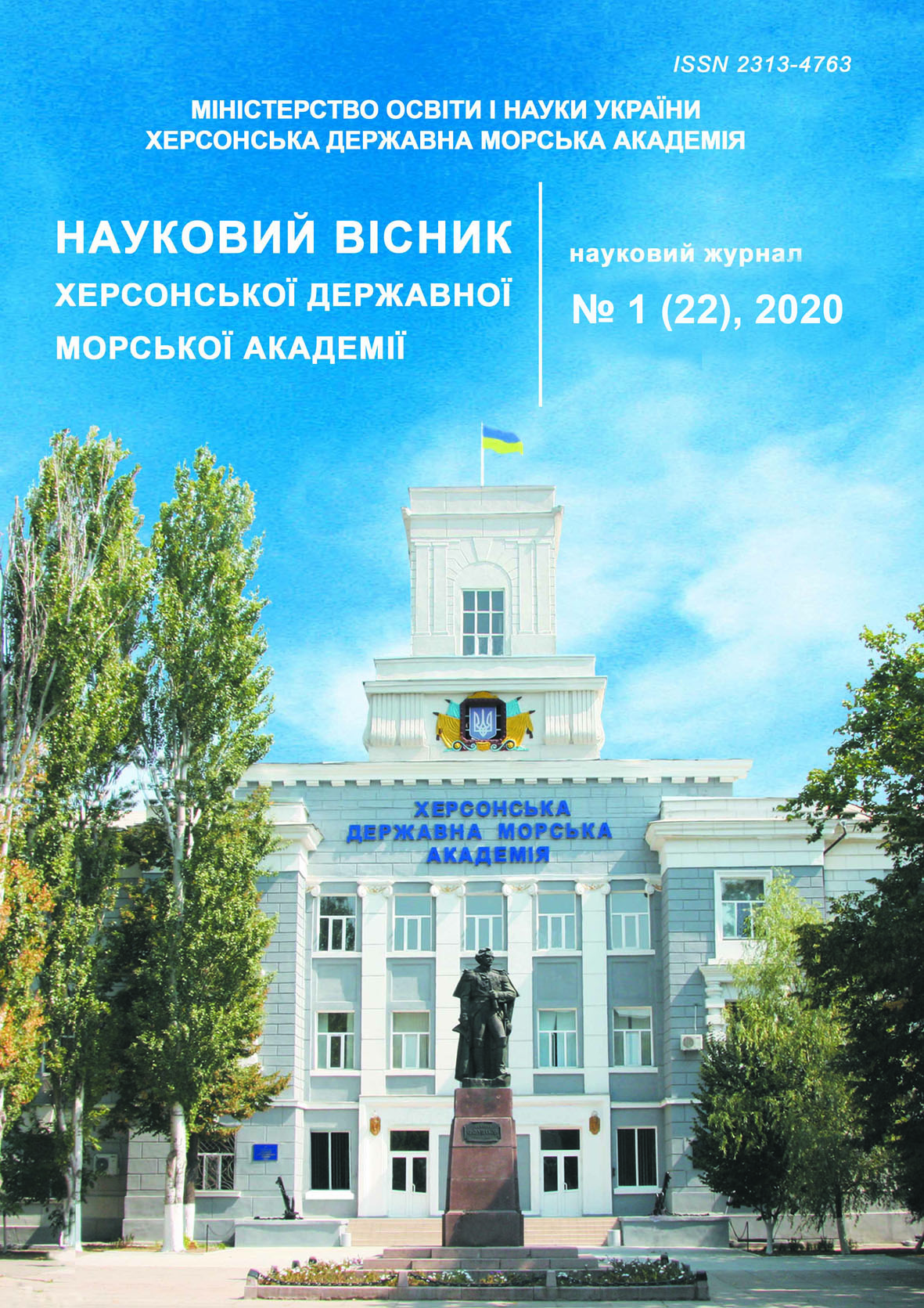GENERATION OF NANO-FILLED EPOXY-POLYESTER COMPOSITE MATERIALS FOR PROTECTION OF ELEMENTS OF VESSEL TECHNICAL MEANS
10.33815/2313-4763.2020.1.22.154-162
Abstract
The influence of nanofillers on thermophysical properties of epoxy-polyester composites has been investigated in the work. The filler content (oxidized nanodisperse additive and pyrogenic silicon dioxide) has been varied within q = 0.02…1.0 pts.wt. per 100 pts.wt. of epoxy oligomer ED-20. It has been discovered that the introduction of the oxidized nanodisperse additive in the amount of q = 0.05…0.08 pts.wt. into the epoxy-polyester binder leads to an improvement in the thermophysical properties of the composite. Value of heat resistance (according to Martens) increased from Т = 335 К (for the epoxy-polyester matrix) to T = 346 K at the content of oxidized nanodisperse additive of q = 0.075 pts.wt. Introduction of q = 0.05 pts.wt. of oxidized nanodisperse additive allows to obtain improved values of the temperature coefficient of linear expansion in different temperature ranges: in the region ΔT = 303…323 K – α = 1.0 × 10-5 K-1, in the region ΔT = 303… 373 K - α = 1.9 × 10-5 K-1, in the region ΔT = 303… 423 K – α = 3.4 × 10-5 K-1. It has been determined that the composite material has also improved its heat resistance (according to Martens), which is T = 347 K and the minimum thermal coefficient of linear expansion at the content of q = 0.05 pts.wt. of pyrogenic silicon dioxide nanofiller. Values of the temperature coefficient of linear expansion were: α = 1.0 × 10-5 K-1 in the region (ΔT = 303… 323 K), α = 1.9 × 10-5 K-1 (in the region ΔT = 303… 373 K), Δα = 3.4 ×× 10-5 K-1 (in the region ΔT = 303… 423 K), α = 8.4 × 10-5 K-1 (in the region ΔT = 303… 473 K). It is recommended that in order to form a composite material with improved thermophysical properties to protect the elements of ship technical equipment, it is advisable to introduce the pyrogenic silicon dioxide nanofiller in the amount of q = 0.05 pts.wt. into the epoxy-polyester binder.
References
2. Sui, C., Stapersma, D., Visser, K., de Vos, P., & Ding, Y. (2019). Energy effectiveness of ocean-going cargo ship under various operating conditions. Ocean Engineering, 190, 106473. https://doi.org/10.1016/j.oceaneng.2019.106473
3. Voznickij, I. V., & Punda, A. S. (2008). Sudovye dvigateli vnutrennego sgoraniya. M. : Morkniga, 1, 282.
4. Kerber, M. L., Vinogradov, V. M., & Golovkin, G. S. (2014). Polimernye kompozicionnye materialy: struktura, svojstva, tekhnologiya. COP «Professiya».
5. Buketov, A., Brailo, M., Yakushchenko, S., & Sapronova, A. (2018). Development of Epoxy-Polyester Composite with Improved Thermophysical Properties for Restoration of Details of Sea and River Transport. Advances in Materials Science and Engineering, 2018, 1–6. https://doi.org/10.1155/2018/6378782
6. Buketov, A. V, Brailo, M. V, Yakushchenko, S. V, Sapronov, O. O., & Smetankin, S. O. (2018). The formulation of epoxy-polyester matrix with improved physical and mechanical properties for restoration of means of sea and river transport. Journal of Marine Engineering & Technology, 1–6. https://doi.org/10.1080/20464177.2018.1530171
7. Salom, C., Prolongo, M. G., Toribio, A., Martínez-Martínez, A. J., de Cárcer, I. A., & Prolongo, S. G. (2018). Mechanical properties and adhesive behavior of epoxy-graphene nanocomposites. International Journal of Adhesion and Adhesives, 84, 119–125. https://doi.org/10.1016/j.ijadhadh.2017.12.004
8. Buketov, A. V, Sapronov, А. А., Buketova, N. N., Brailo, M. V, Marushak, P. О., Panin, S. V, & Amelin, M. Y. (2018). Impact toughness of nanocomposite materials filled with fullerene С60 particles. Composites: Mechanics, Computations, Applications: An International Journal, 9(2), 141–161. https://doi.org/10.1615/CompMechComputApplIntJ.v9.i2.30
9. Zahid, M., Heredia-Guerrero, J. A., Athanassiou, A., & Bayer, I. S. (2017). Robust water repellent treatment for woven cotton fabrics with eco-friendly polymers. Chemical Engineering Journal, 319, 321–332. https://doi.org/10.1016/j.cej.2017.03.006
10. Mostovoi, A. S., Yakovlev, E. A., Burmistrov, I. N., & Panova, L. G. (2015). Use of modified nanoparticles of potassium polytitanate and physical methods of modification of epoxy compositions for improving their operational properties. Russian Journal of Applied Chemistry, 88(1), 129–137. https://doi.org/10.1134/S107042721501019X
11. Szeluga, U., & Moryc, P. (2012). Curing of dicyanate ester/epoxy copolymers modified with polysiloxane and butadiene-acrylonitrile rubbers. Journal of Thermal Analysis and Calorimetry, 109(1), 73–80. https://doi.org/10.1007/s10973-011-1717-0
12. Jana, S., Sui, G., & Zhong, W. H. (2009). Mechanisms for the Improvement in Interfacial Adhesion Between UHMWPE Reinforcement and Nano-epoxy Resins with Reactive Graphitic Nanofibers. Journal of Adhesion Science and Technology, 23(9), 1281–1292. https://doi.org/10.1163/156856109X434008
13. Leonova, N. G., Mikhal’chuk, V. M., Mamunya, Y. P., Davydenko, V. V, & Iurzhenko, M. V. (2013). Thermophysical properties of epoxy-polysiloxane composites of cationic polymerization. Polymer Science Series D. Glues and Sealing Materials, 6(3), 210–217. https://doi.org/10.1134/S1995421213030131
14. Yacishin, O. І., Chervіns’kij, T. І., & Bratichak, M. M. (2012). Vivchennya strukturuvannya epoksidnoї smoli ED-20 u prisutnostі reakcіjnozdatnih olіgomerіv. Vіsnik Nacіonal’nogo Unіversitetu «L’vіvs’ka Polіtekhnіka», 726, 467–471.






